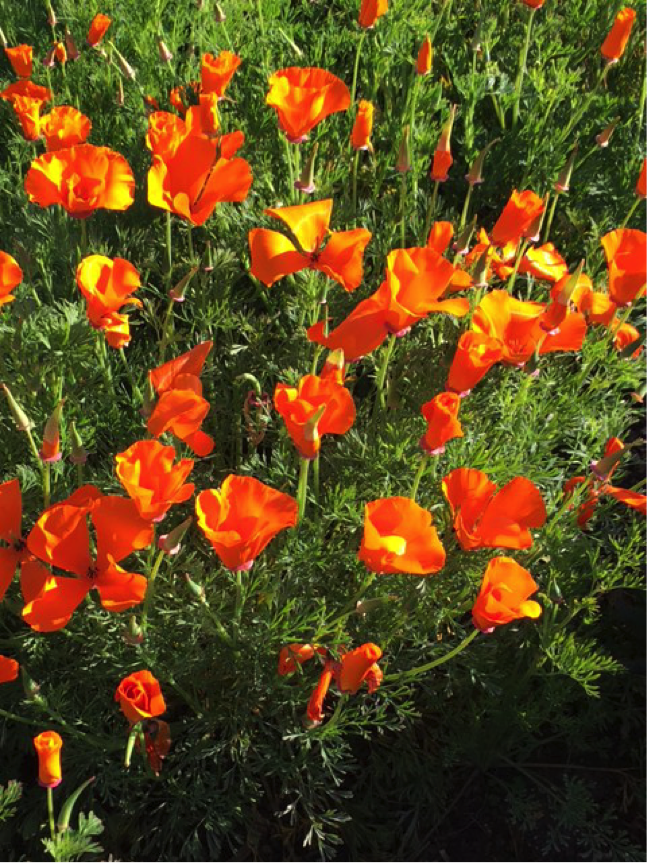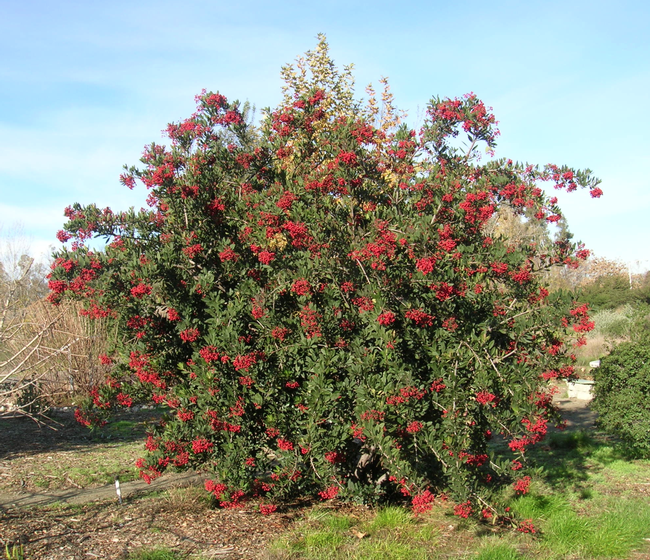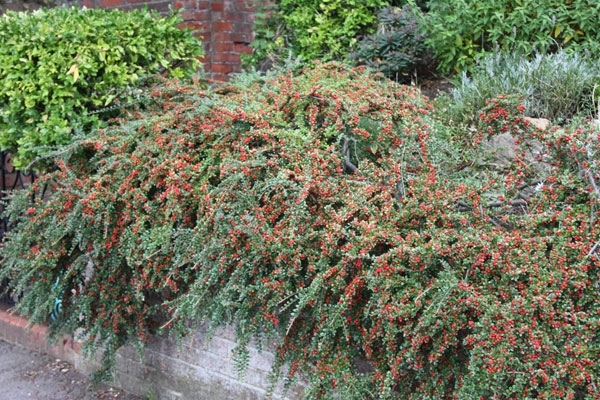- Author: Mandy Salm
- Editor: Kamille Hammerstrom
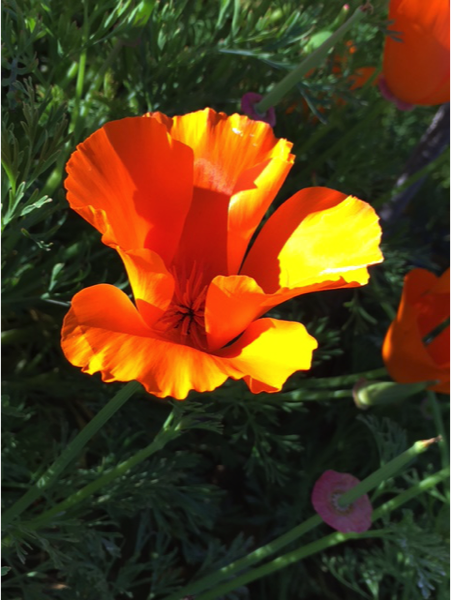
These easy-going, drought tolerant plants sport soft fern-like blue-green foliage and four satiny petals that seem to glow from bright yellow-orange to deep orange. They mature in 55-75 days from seed to flower and favor full sun, poor soil (especially sandy soil) and offer good ground cover when mature. They perform well on slopes providing erosion control. If left to dry and re-seed, the capsules containing 60-100 or more seeds each will disperse themselves by catapulting out of the slender pod up to six feet from the plant. Poppies do not transplant well, nor do they make for good cut flowers, wilting quickly once cut, but they do produce abundant pollen and draw in bumble, honey, sweat and mining bees to pollinate.
This lovely ornamental and medicinal plant became the California state flower in 1903 and is one of eleven species of the Eschscholzia genus naturally occurring in the western US. Growing to 4”-12” tall and 6”-12” wide, they bloom most heavily from March-May. Thrips, aphids and leafhoppers can feed on the sap of the plants and Lepidopteran larvae may feed on the leaves and flowers. Diseases include powdery mildew and gray mold, usually occurring from lack of air circulation and too much humidity.
Some locations to see poppy meadows in spring include:
- Author: Kamille Hammerstrom
- Contributor: Native Plant Subject Group

It's important for us to do our part by avoiding the planting of species that may easily escape cultivation into nearby wild areas. In many cases it is possible to achieve a very similar look with native and non-invasive species. Here are a few suggestions for California native plants that can be used in the landscape in lieu of some common invasive species:

Deer grass (Muhlenbergia rigens) instead of pampas grass
Snowberry (Symphoricarpos albus) instead of English ivy
Wild rose (Rosa californica) instead of periwinkle
Golden currant (Ribes aureum) instead of Scotch or French broom
Toyon (Heteromeles arbutifolia) instead of cotoneaster
For more information on these topics, visit the following sites:
PlantRight is an organization that works to prevent the sale of horticultural invasive plants.
Wildfires can both promote invasive species and be promoted by them.
Eucalyptus can cause loss of biological diversity within its groves and produces lots of flammable debris.
Knowing what a plant's invasive status is can help you decide whether or not to plant it in your garden.
Researchers are learning to predict a plant species' invasion ability to prevent invasions before they occur.
Don't forget to subscribe to our blog so that you receive an email notification when a new post goes up. If you have questions, contact us online, by phone or in person to get answers to your gardening quandaries!
- Author: Ed Morrow
Looking for some good ideas for Christmas gifts for gardening friends and family? These are the three best books to keep within reach if you are a California native plant gardener.
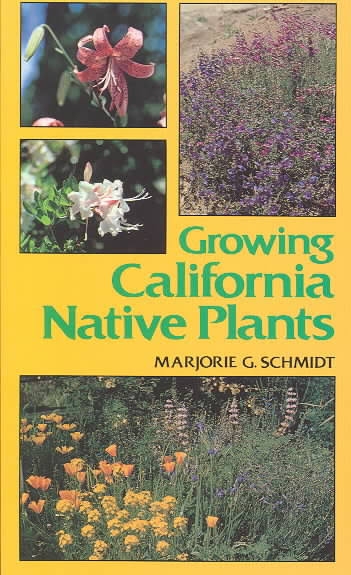
Mrs. Schmidt (1905-1989) was a California native and lived her entire life in California. Born in Berkeley, she spent her childhood summers in Napa with her grandmother, an amateur botanist who introduced her to native plants. Over her lifetime Mrs. Schmidt established three gardens: the first was in Berkeley, the second was in Los Gatos and was known for its extensive collection of Ceanothus (California lilac), and the last was in Hayfork, in Trinity County where she used her 90 foot by 20 foot planting bed to trial plants for drought tolerance. She published her first article “California Natives for California Gardens” in the California Horticultural Society Journal in 1941, and she continued to publish over the next forty years. Her popular column “Natives For Your Garden” ran for ten years in Fremontia, the journal of the California Native Plant Society, and was the basis for her book.
In her opening chapters Mrs. Schmidt introduces California natives, and leads the gardener through the intricacies of preparing and planting seeds, and then explains the techniques of propagation by cuttings, layering, and division. A chapter is devoted to maintaining a native plant garden. The heart of the book is the five chapters that comprehensively cover more than three hundred species of native wildflowers, both annuals and perennials, shrubs, bulbs, and trees. Mrs. Schmidt introduces each plant with a brief botanical description of its habit, foliage, flowers, fruit, and distribution. She follows with a paragraph on how to propagate the plant, along with its requirements for sun, water, and space in the garden. She concludes with an Estimate of Garden Value, assessing the plant's strengths, weaknesses, and suitability for various garden environments.
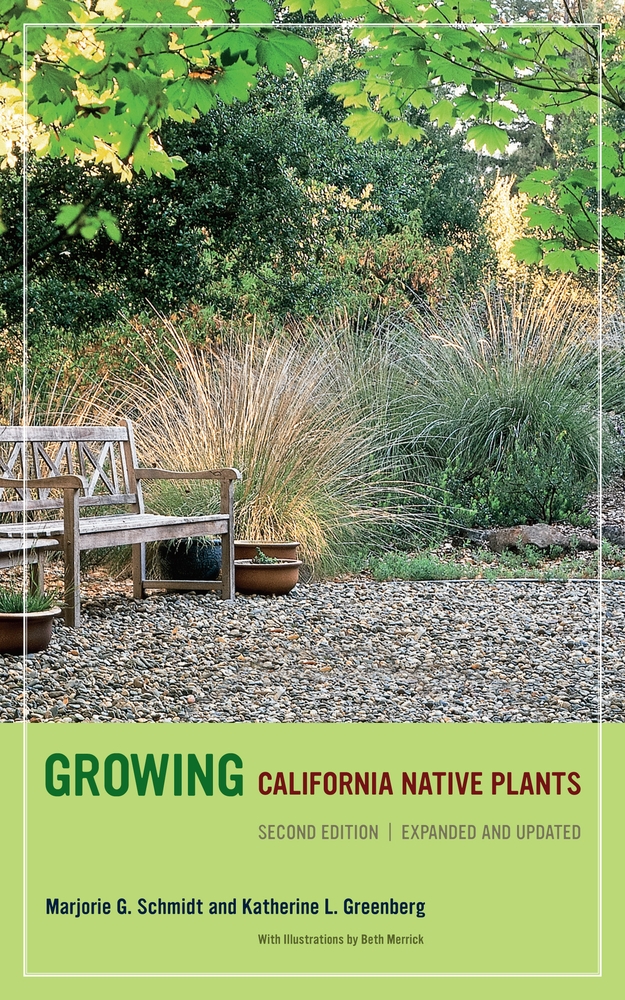
The second edition was written by Katherine L. Greenberg, a fifth generation Californian, born and raised in Monterey County. She is an award winning garden designer, and was at various times the President of the Mediterranean Garden Society and the Pacific Horticulture Society.
Mrs. Greenberg extensively revised Mrs. Schmidt's plant lists. She added plants whose horticultural potential was once unrecognized, like Achillea millefolium, but are now garden staples, and deleted others, Delphiniums for example, whose garden potential was never realized. She introduced a section on plant communities and a chapter on native grasses whose importance grew significantly in the thirty years since the first edition. There is also a new chapter on designing a California native garden.
Why Have Both Editions?
The first and second editions of Growing California Native Plants are really two different books. The first edition is printed on coarse white stock, illustrated with black and white line drawings, and has only eight pages of small color photographs wedged into the middle of the book. The second edition is printed on glossy white paper, and almost every entry is illustrated with a color photograph. Mrs Schmidt's first edition is, however, more technically sophisticated and detailed, especially in the sections on propagation. Mrs. Schmidt does not shy away from using botanical terms to describe plants; and for genera with lots of species, Arctostaphylos (manzanita) and Ceanothus for example, the number of different species she covers is more extensive. In Mrs. Greenberg's second edition the botanical profile is reduced into a brief entry at the heading of each article, but there are chapters on grasses and garden design not in the first edition. Overall, her book more accurately reflects the range of native plants now available at good nurseries. Both editions have a glossary and extensive list of plants for specific situations. The first edition can still be had from on-line bookstores, cost less than four dollars, and is a good investment. I've got two, one for now, and another for when the first one is worn out.
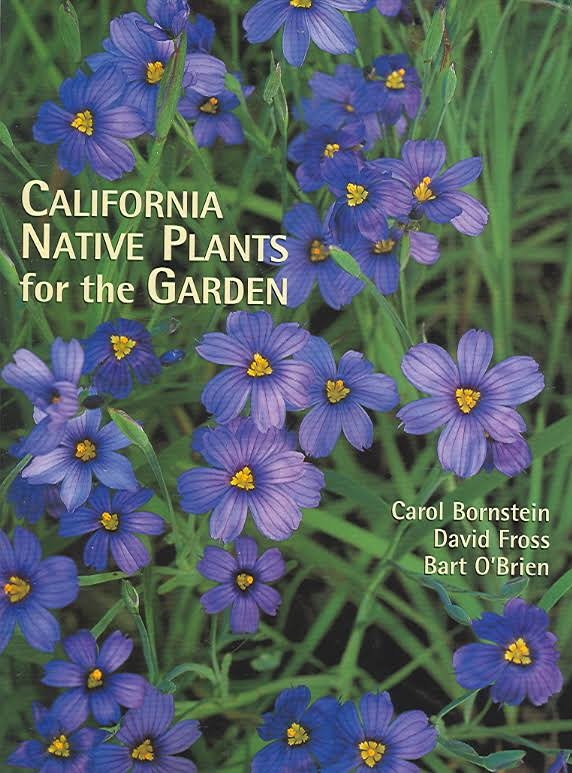
California Native Plants for the Garden is the combined work of three authors. The first, Carol Bornstein, was formerly the Director of Horticulture at the Santa Barbara Botanic Garden and is now the Director of the Nature Gardens at the Natural History Museum of Los Angeles County. David Fross is the founder of Native Sons nursery in Arroyo Grande, California, and lectures at California Polytechnic State University, San Luis Obispo. He is also the author of the the standard work on Ceanothus. Bart O'Brien was for many years the Director of the Rancho Santa Ana Botanic Garden in Claremont, CA, and is now Director of the Regional Parks Botanic Garden located within Tilden Park in the hills above Berkeley, California.
Each entry begins with a brief listing of the plant type, the geographic zones where it will grow, its requirements for light, soil, and water, and its natural habitat and range. What follows is a mini-essay on the plant's growth habit, how to care for the plant, and how it can be used in the garden. If there are cultivars, they are evaluated as well. These mini-essays are thorough, insightful, and give the reader the benefit of the more than 25 years experience of each of the authors.
The decades long arc between Mrs. Schmidt's book and California Native Plants for the Garden is highlighted by the number of cultivars described in this book. Varieties and selections of plants are naturally occurring variations that usually come true when grown from seed. Cultivars, however, are created though human intervention and require vegetative propagation to reproduce. The effort that has gone into the development and production of the large number and stunning variety of cultivars of California natives available in nurseries shows the robustness of native horticulture. The Shrubby Monkeyflower (Mimulus), for example, over the past fifteen years has been bred into a rainbow of colors that vary from white to orange to vivid reds. These patent protected cultivars are a far cry from their wild country cousins who appeared in Mrs. Schmidt's book.
Why garden with California native plants?
For many years California natives earned their place in the garden because they were drought tolerant, or they were bug friendly, or they bolstered the ecosystem. Those are all good reasons, but California natives are also beautiful plants. For a plant to have a place in the garden, regardless of its other virtues, it must be attractive. In a garden just off of Carmel Valley Road there is a Garrya elliptica (silk tassel bush) that in full winter bloom is as memorable as your first sight of a Christmas tree. In the garden at MEarth in Carmel Valley there is a Ribes sanguineum (flowering currant) that in mid-spring is a heart stopping cascade of pink blossoms. That is the message of all three of these books. California natives are beautiful plants and one of the best reasons for living in California.
- Author: Kamille Hammerstrom
- Contributor: Native Plant Subject Group
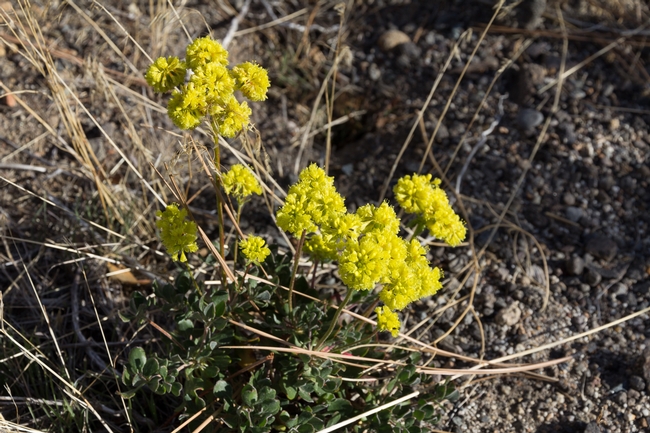
Native buckwheats come in both annual and perennial forms. They are some of the most popular nectar sources for butterflies and beneficial insects. The flowers last a long time, turning a rusty orange or chocolate brown (depending on the species) when the seed heads develop in the fall, so they add interest to the garden in all seasons. Buckwheats are very drought tolerant and some species can even handle salt spray.
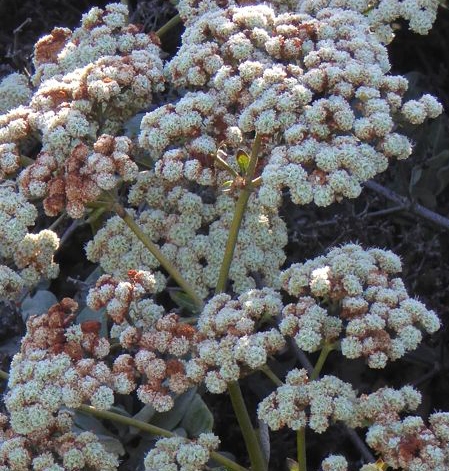
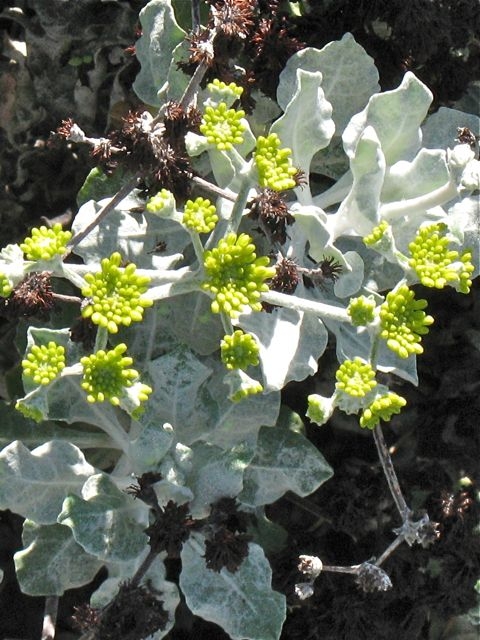
In addition to native plant sales, you can find buckwheats at some of the local native plant nurseries. Check out the California Native Plant Society's search engine for where to buy. For more information on buckwheat, here are some good sources: pests, more information on different species of buckwheat, and their use in hedgerows. To see what buckwheat species are found in your area, visit the Calscape website. You can enter map coordinates or a street address to find a list of California plants that are native to your location. May the buckwheat be plentiful in your future garden!
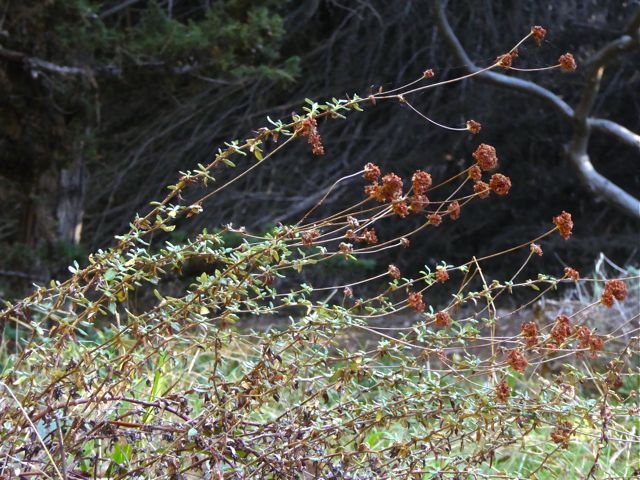
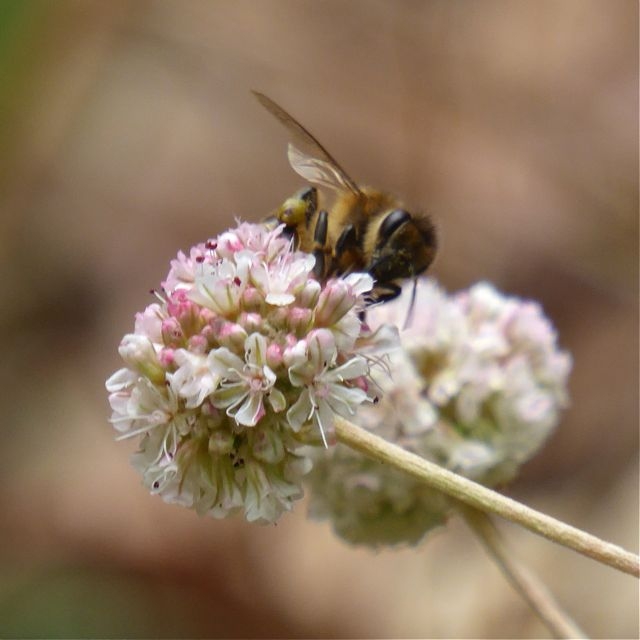
- Author: Kamille Hammerstrom

The take-home point of the article is that a small garden can become a home to many species of wildlife and when there are other small gardens nearby, they become part of a larger habitat corridor for wildlife to live and travel through. As many of you may know, habitat fragmentation is one of the many causes for declines in native species. By creating a mosaic of small native habitats, we gardeners are helping to increase habitat continuity for native animals.
Vogt's article has 4 tips:
- Keep it simple but plant it thick. That means fewer species so your garden doesn't look chaotic. He recommends that 2-3 of the 10-12 species in your 100-200 sq ft garden be grasses or sedges, which provide shelter and nesting material for birds and also tend to outcompete weeds.
- Mass flowers. Vogt recommends 4-6 species of flowering perennials planted in clumps of 2-3 plants. To create more interest in the garden, try to choose species with different flowering times so that you have blooms over a greater period of time.
- Bring in architectural plants for winter interest. Some grasses and perennials have interesting seeds and bracts, and small shrubs may even produce berries. If you have room, consider a small tree with spring flowers and fall or winter fruits.
- Create a path. You could use mulch, decomposed granite or stepping stones. The path will create additional interest.
Because I'm interested in promoting the use of native California plants in the garden, I'd like to suggest a few for each of the tips above. In addition to my selections, the UC Davis Arboretum staff has come up with a list of All-Stars -- tough, reliable plants that have been tested, are easy to grow, require little water, have few problems with pests or diseases, and have outstanding qualities in the garden. Many of them are California native plants that support native birds and insects.
- Grasses and sedges. Some to try: California fescue (Festuca californica), purple needlegrass (Nasella pulchra), blue-eyed grass (Sisyrinchium bellum), foothill sedge (Carex tumulicola), coast melic (Melica imperfecta)
- Mass flowers. You can really have some fun with these. Some to consider: red-flowered buckwheat (Eriogonum grande var. rubescens), California buckwheat (Eriogonum fasciculatum, look for a low-growing cultivar), California fucshia (Epilobium canum -- these bloom in late summer to fall!), harvest brodiaea (Brodiaea elegans, a bulb), wild hyacinth (Dichelostemma capitatum, another bulb), hummingbird sage (Salvia spathacea), one of the shrubby monkeyflowers (Mimulus spp.), coyote mint (Monardella villosa), black sage (Salvia mellifera) or any of the other California sages, margarita BOP penstemon (Penstemon sp.) or one of the many penstemons, California buttercup (Ranunculus californicus)
- Architectural plants for winter interest. I'm leaning more toward winter fruit producers. Some plants and small shrubs to ponder: western redbud (Cercis occidentalis), deer grass (Muhlenbergia rigens), California wild rose (Rosa californica), lemonade berry and sugar bush (Rhus integrifolia and R. ovata), currants and gooseberries (Ribes spp.), one of the smaller manzanita species (Arctostaphylos 'Howard McMinn', Arctostaphylos 'Sentinel', Arctostaphylos edmundsii var. parvifolia 'Bert Johnson')
- Create a path. I suggest whatever you use, you use something permeable to let water percolate back into the sediment.
It's not too late to put in California native plants. They may not completely establish the first year and you might have to water occasionally, but if you get them in soon you can take advantage of the end of the El Nino rains. I consulted with several books in coming up with these suggestions and they are great additions to your garden library:
Bornstein, Fross & O'Brien. 2005. California Native Plants for the Garden. Cachuma Press. Los Olivos, California.
Keater & Middlebrook. 2007. Designing California Native Gardens: the Plant Community Approach to Artful, Ecological Gardens. University of California Press. Berkeley, California.
Also worth checking out is the California Native Plant Society website. Both Monterey and Santa Cruz chapters are active and the website has a database of nurseries that sell native plants. The UC Master Gardeners of Monterey Bay's Local Resources page also has some useful links.
What are you waiting for? Time to get gardening!

